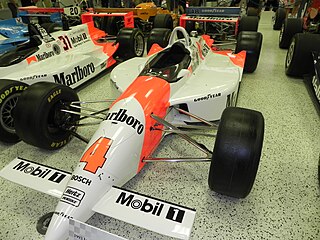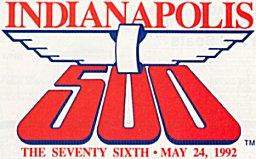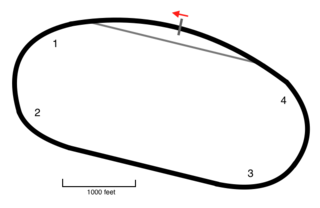
The 80th Indianapolis 500 was held at the Indianapolis Motor Speedway in Speedway, Indiana on Sunday, May 26, 1996. This was the first Indy 500 contested as part of the new Indy Racing League, under the overall sanctioning umbrella of USAC. It was the third and final race of the 1996 IRL season. Veteran driver and former AIS champion Buddy Lazier won the race, his first career victory in top-level Indy car competition. Lazier's victory came just over two months after he suffered a broken back in a crash at Phoenix.

The 79th Indianapolis 500 was held at the Indianapolis Motor Speedway in Speedway, Indiana on Sunday, May 28, 1995. Sanctioned by USAC, it was part of the 1995 CART PPG Indy Car World Series season. Jacques Villeneuve won in his second start. After dominating the 1994 race and the 1994 IndyCar season, Marlboro Team Penske failed to qualify for the race. Two-time and defending Indy 500 winner Al Unser Jr. and two-time winner Emerson Fittipaldi (bumped) could not get their cars up to speed. A noticeable period of decline followed for the team until 2000 when Gil de Ferran won the CART championship, and subsequently the team returned to Indianapolis in 2001.

The 78th Indianapolis 500 was held at the Indianapolis Motor Speedway in Speedway, Indiana on Sunday, May 29, 1994. The race was sanctioned by United States Auto Club (USAC), and was included as race number 4 of 16 of the 1994 PPG IndyCar World Series. For the second year in a row, weather was nary a factor during the month. Only one practice day was lost to rain, and pole day was only partially halted due to scattered showers. Warm, sunny skies greeted race day.

The 77th Indianapolis 500 was held at the Indianapolis Motor Speedway in Speedway, Indiana on Sunday, May 30, 1993. Emerson Fittipaldi took the lead with 16 laps to go, and won his second career Indy 500 victory. The race was sanctioned by USAC and was part of the 1993 PPG Indy Car World Series. Several sidebar stories during the month complemented one of the most competitive Indy 500 races in recent years.

The 76th Indianapolis 500 was held at the Indianapolis Motor Speedway in Speedway, Indiana, on Sunday, May 24, 1992. The race is famous for the fierce battle in the closing laps, as race winner Al Unser Jr. held off second place Scott Goodyear for the victory by 0.043 seconds, the closest finish in Indy history. Unser Jr. became the first second-generation driver to win the Indy 500, following in the footsteps of his father Al Unser Sr. He also became the third member of the famous Unser family to win the race.

The 75th Indianapolis 500 was held at the Indianapolis Motor Speedway in Speedway, Indiana, on Sunday, May 26, 1991. Rick Mears won from the pole position, becoming the third four-time winner of the Indy 500, joining A. J. Foyt and Al Unser. During time trials, Mears also established an Indy record by winning his sixth career pole position. The month of May for Mears was tumultuous, as he suffered his first ever crash at Indy since arriving as a rookie in 1977. The wreck during a practice run totaled his primary car, and broke a bone in his right foot. Mears kept the injury mostly secret, and later admitted that the pain he experienced during the race was so bad, he had to cross his legs in the car and push the accelerator pedal down with his left foot.

The 73rd Indianapolis 500 was held at the Indianapolis Motor Speedway in Speedway, Indiana on Sunday, May 28, 1989. The race was won by two-time Formula One World Drivers' Champion Emerson Fittipaldi. Fittipaldi's victory made him the first Indianapolis 500 winner from Brazil, the first foreign-born winner of the race since Mario Andretti in 1969, and the first non-American winner since Graham Hill in 1966. Though Fittipaldi started on the front row and dominated much of the race, he found himself running second in the waning laps. Michael Andretti passed Fittipaldi for the lead on lap 154, then led until his engine blew. Al Unser Jr. moved up to second, but trailed Fittipaldi by a big margin. Gambling on fuel mileage, Unser caught up to Fittipaldi after a fortuitous caution period on lap 181, and subsequently took the lead on lap 196.

The 72nd Indianapolis 500 was held at the Indianapolis Motor Speedway in Speedway, Indiana, on Sunday May 29, 1988. Team Penske dominated the month, sweeping the top three starting positions with Rick Mears winning the pole position, Danny Sullivan at the center of the front row, and Al Unser, Sr. on the outside. Mears set a new track record, becoming the first driver to break the 220 mph barrier in time trials. On race day, the Penske teammates proceeded to lead 192 of the 200 laps, with Rick Mears taking the checkered flag, his third-career Indy 500 victory. The race represented the milestone 50th victory in Championship car racing for owner Roger Penske and Penske Racing.

The 71st Indianapolis 500 was held at the Indianapolis Motor Speedway in Speedway, Indiana, on Sunday May 24, 1987. After dominating practice, qualifying, and most of the race, leader Mario Andretti slowed with mechanical problems with only 23 laps to go. Five laps later, Al Unser Sr. assumed the lead, and won his record-tying fourth Indianapolis 500 victory. At age 47, just days short of his 48th birthday, Unser became the oldest winner of the Indy 500, a record that still stands as of 2023. During the month of May, an unusually high 25 crashes occurred during practice and qualifying, with one driver in particular, Jim Crawford, suffering serious leg injuries.

The 69th Indianapolis 500 was held at the Indianapolis Motor Speedway in Speedway, Indiana, on Sunday, May 26, 1985. The race was sanctioned by USAC, and was included as part of the 1985 CART PPG Indy Car World Series. The Speedway also celebrated 40 years of ownership by the Hulman/George family.

The 68th Indianapolis 500 was held at the Indianapolis Motor Speedway in Speedway, Indiana on Sunday May 27, 1984. Rick Mears, who previously won in 1979, won his second Indy 500 victories driving for Penske. Contenders Tom Sneva and Mario Andretti dropped out of the race in the second half, leaving Mears alone two laps ahead of the field, and he cruised to the victory. Three months after the race, however, Mears would suffer severe leg injuries in a practice crash at Sanair.

The Michigan 500 was an IndyCar Series race held at Michigan International Speedway in Brooklyn, Michigan. Held from 1981 to 2001, the event was held in high prestige, constituting part of Indy car racing's 500-mile "Triple Crown".

The Jimmy Bryan Memorial was an IndyCar Series race held at the Phoenix Raceway in Avondale, Arizona, United States. USAC moved the fall race and added a spring race to the newly built Phoenix International Raceway in 1964. The race became a CART event in 1979, and joined the Indy Racing League in 1996. It was held continuously through 2005.
The Marlboro Challenge was an all-star race in the CART series race held from 1987 to 1992, sponsored by cigarette brand Marlboro. After 1992, the race was discontinued, in part because Phillip Morris reorganized its race sponsorship after the Marlboro Grand Prix of New York fell through. The race was considered a non-points exhibition race, and did not count towards championship standings or official statistics.

The 1995 PPG Indy Car World Series season was the seventeenth in the Championship Auto Racing Teams (CART) era of U.S. American open-wheel car racing. It consisted of 17 races, beginning in Miami, Florida on March 5 and concluding in Monterey, California on September 10. The PPG Indy Car World Series Drivers' Champion and Indianapolis 500 winner was Jacques Villeneuve. Rookie of the Year was Gil de Ferran. This was the last season before the formation of the Indy Racing League by Indianapolis Motor Speedway owner, Tony George, and the last time the United States Auto Club-sanctioned Indianapolis 500 would appear in the Series.

The 1994 PPG Indy Car World Series season was the 16th national championship season of American open wheel racing sanctioned by CART under the name "IndyCar". The season consisted of 16 races. Al Unser Jr. was the national champion, his second CART title, and the rookie of the year was Jacques Villeneuve. The 1994 Indianapolis 500 was sanctioned by USAC, but counted towards the CART points championship. Al Unser Jr. won the Indy 500 from the pole position, his second career victory in that event.

The 97th Indianapolis 500 was held at the Indianapolis Motor Speedway in Speedway, Indiana on Sunday May 26, 2013. It was the premier event of the 2013 IZOD IndyCar Series season. Tony Kanaan, a native of Brazil, was victorious on a record-setting day. Kanaan became the fourth Brazilian driver to win the Indianapolis 500 joined by Emerson Fittipaldi, Helio Castroneves, and Gil de Ferran.

The 1985 Michigan 500, the fifth running of the event, was held at the Michigan International Speedway in Brooklyn, Michigan, on Sunday, July 28, 1985. The event was race number 7 of 15 in the 1985 CART PPG Indy Car World Series. The race was won by Emerson Fittipaldi, his first Indy Car victory. The race was delayed for one week over concerns about Goodyear's new radial tires.

The 1990 Michigan 500, the tenth running of the event, was held at the Michigan International Speedway in Brooklyn, Michigan, on Sunday, August 5, 1990. Branded as the 1990 Marlboro 500 for sponsorship reasons, the event was race number 10 of 16 in the 1990 CART PPG Indy Car World Series. The race was won by Al Unser Jr., his first 500-mile Indy Car victory. With an average speed of 189.727 mph, it remained the fastest 500 mile Indy car race until the 2002 The 500 at California Speedway.

The 1991 Marlboro 500, the eleventh running of the event, was held at the Michigan International Speedway in Brooklyn, Michigan, on Sunday, August 4, 1991. Branded as the 1991 Marlboro 500 for sponsorship reasons, the race was won by Rick Mears, his final Indy Car victory. It was also Mears' only win in the Michigan 500. The event was race number 11 of 17 in the 1991 CART PPG Indy Car World Series.



















